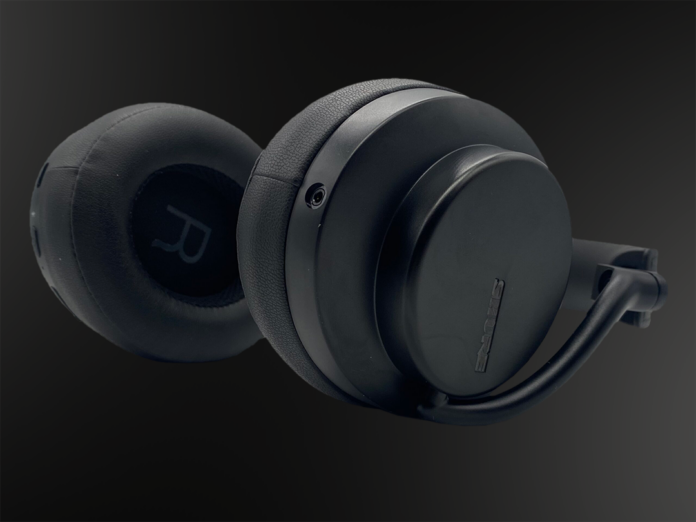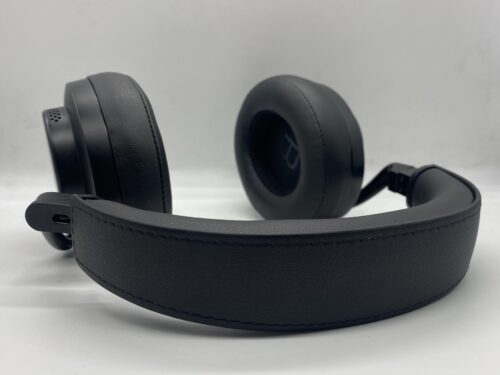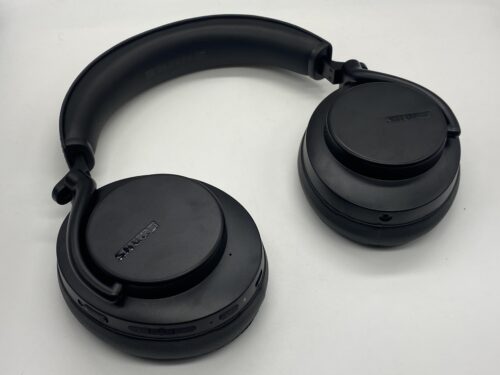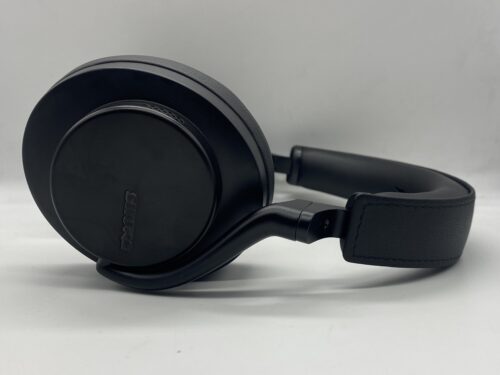It’s been a couple of years since Shure released their first over-ear wireless headphone. Since then, the Aonic 50 has seen a lot of competition, but has remianed a strong offering. Now it’s time fot the next generation of this product line, with the Aonic 50 Gen 2 finally hitting store shelves. It posesses a lot of promise, including new spatial audio features and better barrery life. Can the Aonic 50 Gen 2 be a new heavy hitter for Shure?
What You Get
- 1 Premium zippered carrying case
- 1 Detachable USB-C charging/communication/audio cable
- 1 Analog audio cable (3.5mm)
Look & Feel
With the Gen 2, Shure doesn’t give the Aonic 50 a redesign. I was a fan of how classy and ridgid the original look, so I’m glad the same style is carried over here. The only difference here is that the Gen 2 loses some of its silver accents and goes for a more typical all-black color. Because the design is mostly the same, the Gen 2 posseses the same level of comfort from the previous version.
Design & Functioanlity
The Gen 2 features a 50mm dynamic driver that gives you plenty of volume and headroom for your wireless signal. A common issue I found with the original Aonic 50 was its limited room for loudness, so I’m glad that seems to be fixed here. What doesn’t recive the biggest upgrade is noise canceling, as the Gen 2 can’t really compare to even the Momentum 4’s level of isolation. It still does its job, just don’t expect anything that will come even close to matching Sony’s ANC technology.
You can sort through different levels of noise-canceling through Shure’s PlayPlus companion app, which hosts some new features with the Gen 2. The most notable new addition is the inclusion of spatial audio, which offers a few different modes of effect. There’s music, cinema, and podcast mode, which will are tailor made for their own experiences. This isn’t specifically Dolby Atmos, or 360 Reality Audio, but Shure’s own spatializar that they’ve built into their app. Lastly, you have an EQ that allows you to adjust 4 bands of frequency, including their Q size. So far, this has consistently been one of the most effective EQ’s out of any Bluetooth headphone companion app.
Bluetooth
The Gen 2 reliably uses Bluetooth version 5, and gives you fast pairing with a stable connection that I never had issue with. It also provides a list of solid CODECs including aptx HD and LDAC.
Battery Life
The last Aonic 50 didn’t have the best battery life, but the Gen 2 looks to change that with a new 45 hours of total playtime. It’s not quite the 60 that you get from the Momentum 4, but still more than fair.
Soundstage
Everything about the Gen 2’s soundstage and profile centers around its personalization options. The default experience isn’t very impressive, congealing its width closer to the middle than spreading to the left and right channels. EQ is almost required for you to listen to a track with any sort of wingspan. The mids and highs needed the most work, and once those areas were properly adjusted to my liking, the soundstage started to make more of an impression on me.
Instruments started to spread out and display better stereo positioning. The Gen 2 even separates the sound elements with some notable air in between. When you start to implement the Gen 2’s new spatial audio modes, it only adds more variation to the soundstage and imaging. While there are a few different spatial audio modes, I kept the Aonic 50 in music mode for the majority of my listening.
Not every track responded quite right to it, but it depends on the genre. Hard rock tracks sounded too centered, while only expanding the headspace marginally. Its effect was to place the performance directly in front of you rather than around you. Lighter chamber rock and ambient post-rock achieved more spatial qualities more in line with Dolby Atmos tracks.
Low End
Without EQ, the bass still feels like the focus of the sound signature. It needs some cleaning up, but it still provides some hearty punch. Most of its response is surface-level resonance, and never really comes into form. However, with EQ, the bass becomes not only more bodied but greater emphasis on the sub-bass giving the lows a whole new character. The bass slams down harder and deeper, offering better rumble with smoother grooves. It establishes better clarity too, showcasing a more identifiable shape to the lows. It can get to a point where the bass is the most engrossing range of frequency on the Gen 2, and spatial audio helps give it the space it needs for maximum expression without being overbearing.
Mids
The last version of the Aonic 50 had a very distinct v-shaped sound signature, and that’s the case for the Gen 2 as well. You can get the mids to sit sufficiently in the mix with EQ, but it’ll never expand on much great detail. Without it though, instruments can come across as a bit dull and underpowered. Spatial audio mode even adds some identity to the midrange, particularly vocals which are able to cut through a lot more clearly.
Highs
By just the simple act of adding a high shelf in the app’s EQ, the Gen 2 is able to deliver some nice treble. It receives a nice coating of sizzle that’s just subtle enough to give you that blissful feel. With spatial audio turned on, the highs receive a crisper response, as well as some extended height to add a nice tail to underline certain sound elements.
Summary
As long as you keep messing around with EQ and the spatializer, the Shure Aonic 50 Gen 2 can sound like no other pair of Bluetooth headphones. That might not be true right out of the box, but those in-app features are really what makes the Gen 2 a complete package. Not everything works about its sound one hundred percent of the time, but that doesn’t mean it can’t make its mark. With the right tracks and settings, the Gen 2 surpasses that mark for me. Other features like ANC are still lacking, but it’s still an experience that’s hard to match by its competitors.
| Pros | Cons |
| · Highly adjustable sound signature
· Spatial audio sound · Sturdy build · PlayPlus App · LDAC and aptX HD compatibility · Battery Life |
· Weak ANC
· Dull sound without EQ |
The Shure Aonic 50 Gen 2 is available at Audio46.
Compare the ranking of various headphones, earbuds and in-ear monitors using our tools.
Discuss this, and much more, over on our forum.
---MAJORHIFI may receive commissions from retail offers.


















